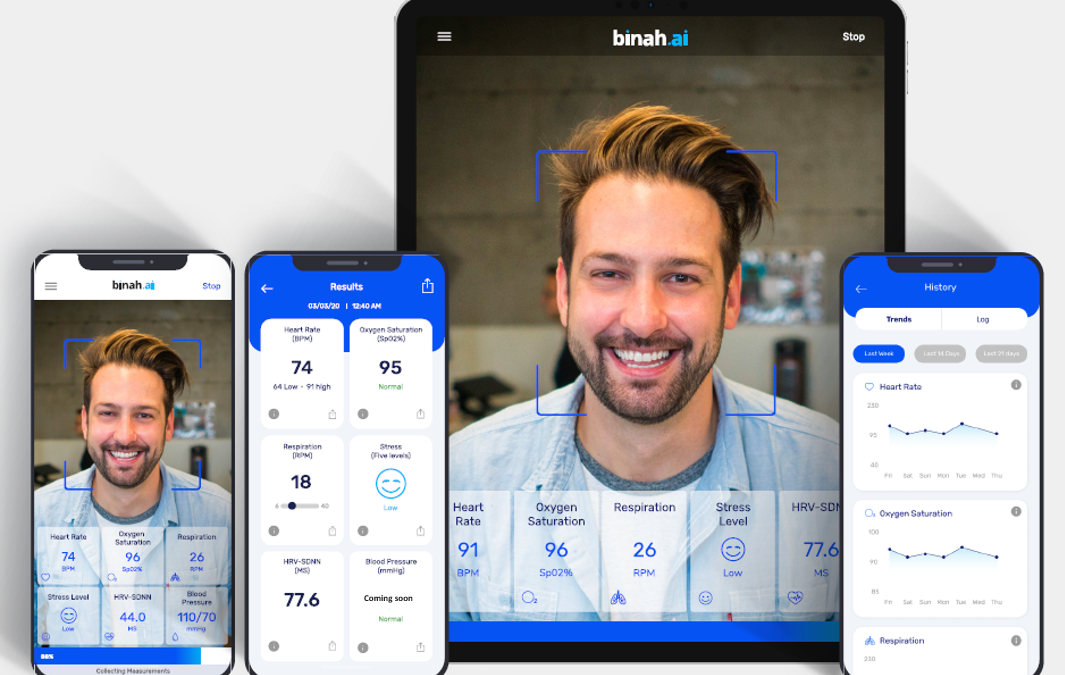
Technology has shifted the healthcare landscape––gone are the days when the internet’s capabilities began and ended with a self-diagnosis via Google, as innovators continue to advance platforms and applications. With advancements in recent years, including Apple’s announcement to launch their Apple Watch to detect atrial fibrillation or the move towards electronic health records to give patients access to their health data from their phones, the possibilities seem endless.
While 2009 may have spurred the beginning of the healthtech boom, it is arguably the COVID-19 pandemic that catapulted digital health innovation to new heights. New challenges ranging from tracking the spread of COVID-19 to managing increased stress levels amid the pandemic have ushered the rapid invention and adoption of technologies that helped manage life during these unprecedented times.
One example of this technology is Binah.ai, a remote vital sign monitoring solution that utilizes smart devices, tablets and laptops built-in cameras to extract vital signs such as heart rate, respiration rate and mental stress levels — all from the comfort and safety of home. Users simply look at their smart device’s camera and receive medical-grade accurate readers in under a minute. Companies across the globe are already implementing this technology to enhance employee safety when returning to work or to offer corporate wellness solutions while many are still working remote.
In addition to remote vital sign monitoring, individual U.S. states partnered with Apple and Android to deliver built-in COVID-tracking apps. For example, New York State instituted Traveler Health Forms which helped public health officials track out-of-state travelers, and ultimately, managed COVID-19 exposure. Travelers continue to access the forms through their mobile phones and can be reached by contact tracers in the event that they have been exposed.
While there are applications that directly support the fight to end the pandemic, myriad facets of the healthcare industry were impacted, including clinical trials. According to the Association of Clinical Research Professionals, the pandemic created an urgent need to adopt remote monitoring tools to ensure clinical trials continue, to support mitigating the virus through patients visiting clinical trial sites. In May 2020, Cmed Technology announced a new app to optimize at-home clinical trial visits. Adopting these technologies means the benefits reaped as a result of the pandemic will remain, fostering efficiencies to support the development of new therapies long after the pandemic subsides. While social distancing and similar precautions meant we needed to find a new way to continue the essential aspects of life, the rapid adoption of technology allowed the healthcare industry to quickly adapt to the new normal.
The “new normal” has also included stay-at-home restrictions across the globe, adding another layer to the ways healthtech infiltrated the pandemic. The newfound solitude and monotony of staying home has had a trickle down effect for consumers struggling with increased stress levels and plummeting activity levels. For example, fitness apps peaked in May, right in the middle of lockdowns, according to data from Apptopia. In the same report, Apptopia found that 6 out of every 10 apps downloaded offered video workouts. Beyond exercise apps, there was also an increased interest in meditation apps like Headspace. Similarly, Apple’s year-end highlights awarded ‘The iPhone app of the year’ to Wakeout!––an inclusive and lighthearted app packed to the brim with exercises you can do from home.
In 2009, the first doctor entered information into a health record on an iPhone. Twelve years later, we can see that the possibilities are virtually endless. Our phones can measure our stress levels, take medical-grade vital signs measurements and send a photo of our dog to a friend––all within the same ten minutes.
Looking ahead, we predict digital-first primary care will evolve even further to meet the afield challenges presented by COVID-19. Evolving themes such as physician burnout, the backlog of nonessential health appointments and digital-first primary care are ripe for innovation. We remain (cautiously) optimistic for the advancements these ongoing challenges will inspire within the healthcare industry.